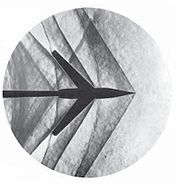
Mach wave
Encyclopedia

Fluid dynamics
In physics, fluid dynamics is a sub-discipline of fluid mechanics that deals with fluid flow—the natural science of fluids in motion. It has several subdisciplines itself, including aerodynamics and hydrodynamics...
, a Mach wave is a pressure wave traveling with the speed of sound
Speed of sound
The speed of sound is the distance travelled during a unit of time by a sound wave propagating through an elastic medium. In dry air at , the speed of sound is . This is , or about one kilometer in three seconds or approximately one mile in five seconds....
caused by a slight change of pressure
Pressure
Pressure is the force per unit area applied in a direction perpendicular to the surface of an object. Gauge pressure is the pressure relative to the local atmospheric or ambient pressure.- Definition :...
added to a compressible flow
Compressible flow
Compressible flow is the area of fluid mechanics that deals with fluids in which the fluid density varies significantly in response to a change in pressure. Compressibility effects are typically considered significant if the Mach number of the flow exceeds 0.3, or if the fluid undergoes very large...
. These weak waves can combine in supersonic flow to become a shock wave
Shock wave
A shock wave is a type of propagating disturbance. Like an ordinary wave, it carries energy and can propagate through a medium or in some cases in the absence of a material medium, through a field such as the electromagnetic field...
if sufficient Mach waves are present at any location. Such a shock wave is called a Mach stem or Mach front. Thus it is possible to have shockless compression or expansion in a supersonic flow by having the production of Mach waves sufficiently spaced (cf. isentropic compression in supersonic flows). A Mach wave is the weak limit of an oblique shock wave (a normal shock is the other limit). They propagate across the flow at the Mach angle μ :

where M is the Mach number
Mach number
Mach number is the speed of an object moving through air, or any other fluid substance, divided by the speed of sound as it is in that substance for its particular physical conditions, including those of temperature and pressure...
.
Mach waves can be used in schlieren
Schlieren photography
Schlieren photography is a visual process that is used to photograph the flow of fluids of varying density. Invented by the German physicist August Toepler in 1864 to study supersonic motion, it is widely used in aeronautical engineering to photograph the flow of air around objects...
or shadowgraph observations to determine the local Mach number of the flow. Early observations by Ernst Mach
Ernst Mach
Ernst Mach was an Austrian physicist and philosopher, noted for his contributions to physics such as the Mach number and the study of shock waves...
used grooves in the wall of a duct to produce Mach waves in a duct, which were then photographed by the schlieren method, to obtain data about the flow in nozzles and ducts. Mach angles may also occasionally be visualized out of their condensation in air, as in the jet photograph below.
_-_filtered.jpg)
See also
- Gas dynamicsGas dynamicsGas dynamics is a branch of fluid dynamics concerned with studying the motion of gases and its consequent effects. Gas dynamics combines the principles of fluid mechanics and thermodynamics...
- Prandtl-Meyer expansion fanPrandtl-Meyer expansion fanA Prandtl–Meyer expansion fan is a centered expansion process, which turns a supersonic flow around a convex corner. The fan consists of an infinite number of Mach waves, diverging from a sharp corner. In case of a smooth corner, these waves can be extended backwards to meet at a point. Each wave...
- Shadowgraph techniqueShadowgraphShadowgraph is an optical method that reveals non-uniformities in transparent media like air, water, or glass. It is related to, but simpler than, the schlieren and schlieren photography methods that perform a similar function...
- Schlieren photographySchlieren photographySchlieren photography is a visual process that is used to photograph the flow of fluids of varying density. Invented by the German physicist August Toepler in 1864 to study supersonic motion, it is widely used in aeronautical engineering to photograph the flow of air around objects...
- Shock waveShock waveA shock wave is a type of propagating disturbance. Like an ordinary wave, it carries energy and can propagate through a medium or in some cases in the absence of a material medium, through a field such as the electromagnetic field...

